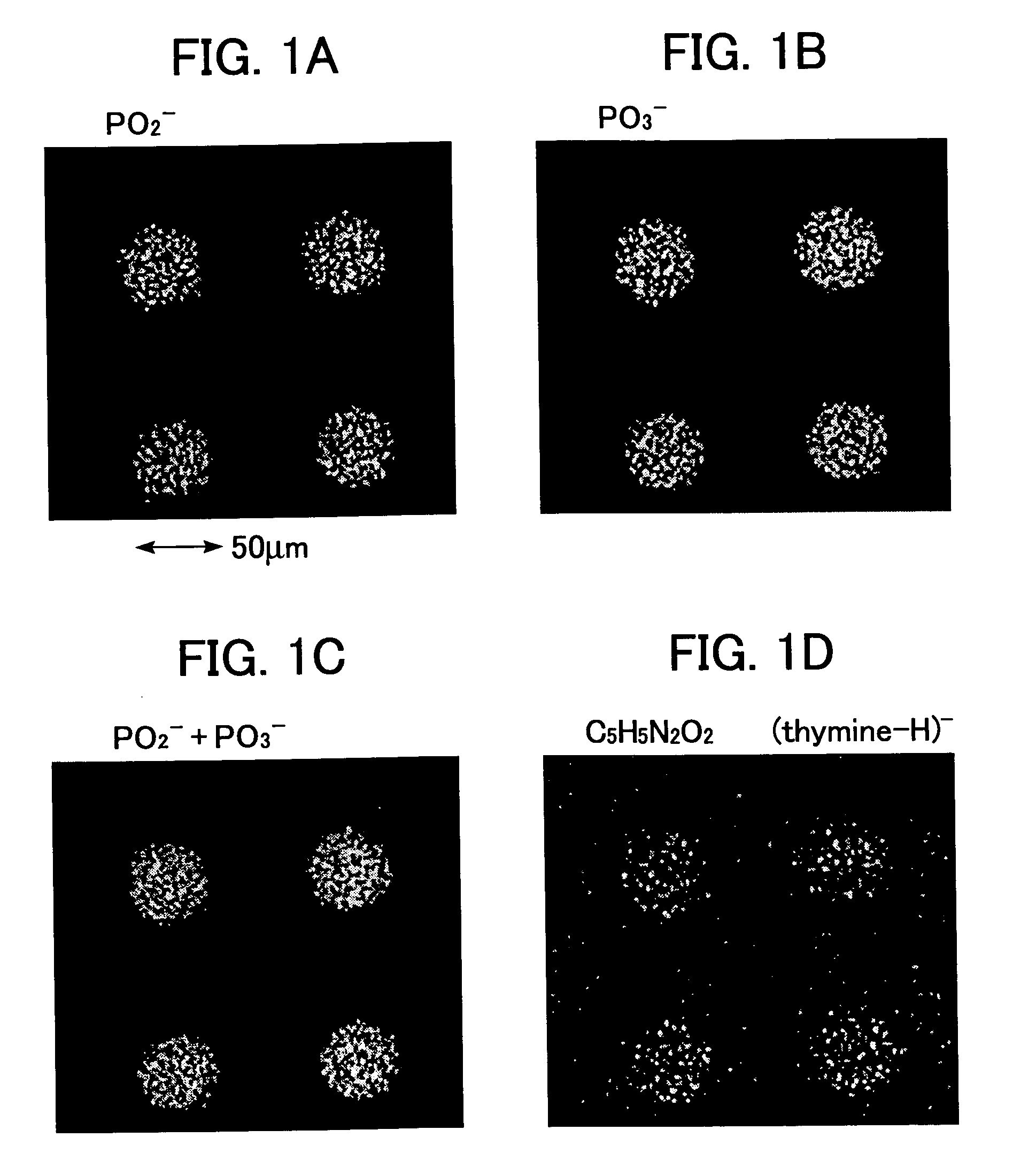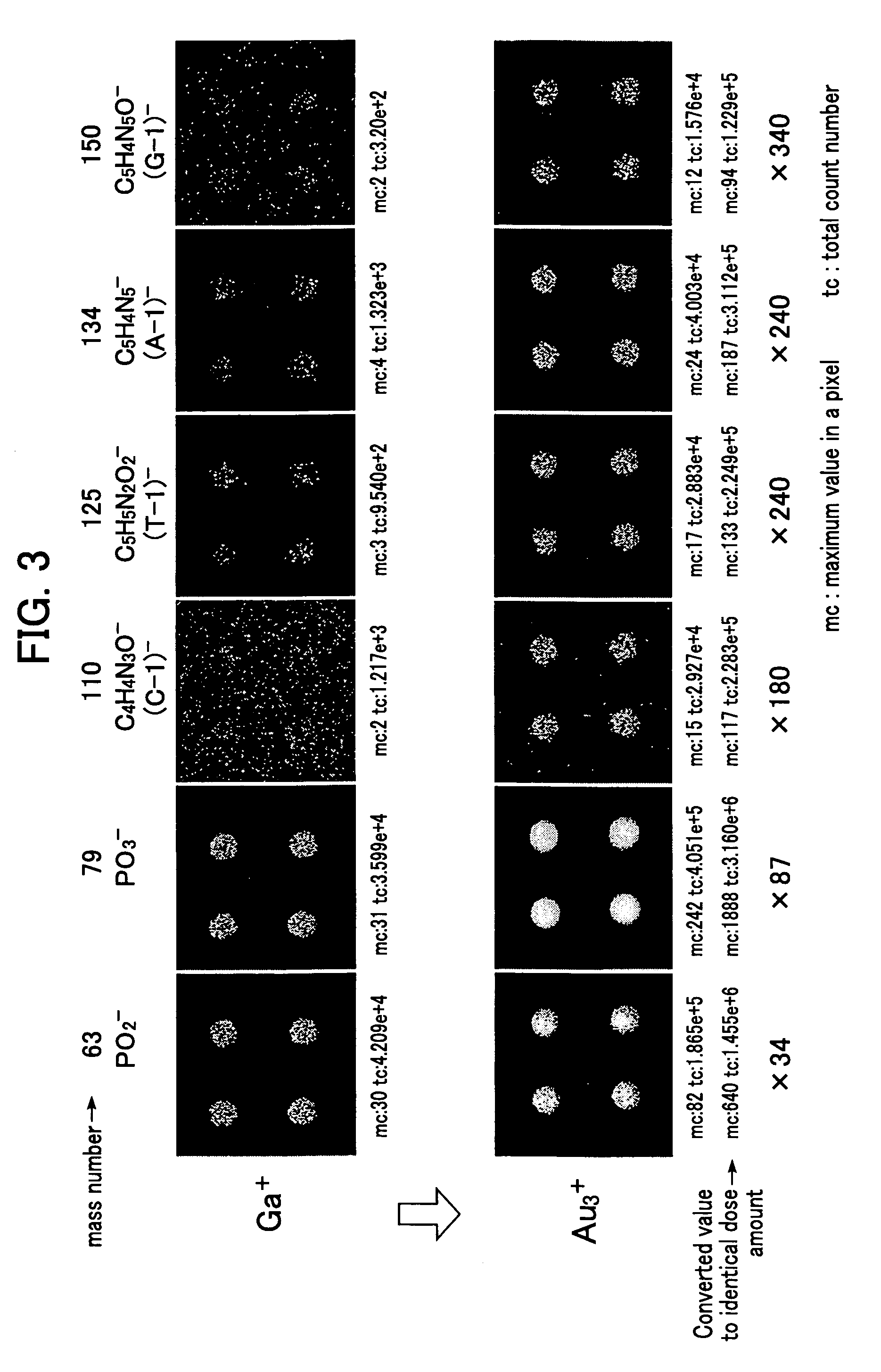Method for acquiring information of a biochip using time of flight secondary ion mass spectrometry and an apparatus for acquiring information for the application thereof
a biochip and secondary ion mass spectrometry technology, applied in the field of biochip secondary ion mass spectrometry acquisition information and the application of an apparatus, can solve the problems of complicated method, unclear determination of the position of the probe portion, and special facilities and special equipment, and achieve the effect of high resistivity and better quantitative ability
- Summary
- Abstract
- Description
- Claims
- Application Information
AI Technical Summary
Benefits of technology
Problems solved by technology
Method used
Image
Examples
example 1 preparation
of a Nucleic Acid Probe Chip by Using a dT40 Probe
[0068]A nucleic acid probe was prepared by using quartz glass, similarly as in the method described in the Japanese Patent Laid-Open No. H11-187,900 (1999).
(1) Washing of the Substrate
[0069]A 25.4 mm×25.4 mm synthesized quartz substrate mm was placed on a rack and immersed in a solution containing a detergent for ultrasonic washing (GPIII, commercially available from BRANSON) diluted to 10% with pure water for one night. Then, the substrate was ultrasonic-washed in the detergent solution for 20 minutes and then washed with water to remove the detergent. After being rinsed with pure water, the substrate was further ultrasonic-washed within a container containing pure water for 20 minutes. Next, the substrate was immersed in an aqueous solution of 1N sodium hydroxide that was pre-heated to 80° C. for 10 minutes. Sequentially, the substrate was washed with water and further washed with pure water, and the washed substrate was transferre...
example 2
Imaging and Composition Analysis Via TOF-SIMS
(1) Operations
[0077]The imaging and the composition analysis for the DNA chip prepared in the above-mentioned Example 1 were carried out by using a “TOF-SIMS IV” apparatus, which is commercially available from ION TOF CO. LTD.
[0078]The apparatus and conditions used in this operation are listed below.
[0079]
primary ion beam: 25 kV, Ga+, 0.6 pA (pulse current), random scan mode;
pulse frequency of the primary ion beam: 2.5 kHz (400 μsec. / shot);
pulse width of the primary ion beam: 1 ns; and
beam diameter of the primary ion beam: 5 μm.
detection mode for secondary ion: negative;
area for the measurement: 300 μm×300 μm;
number of pixel in the secondary ion image: 128×128 pixels; and
number of integrating operation: 256.
(2) Measurement Results
[0080]FIG. 1 shows the results of the imaging for the typical ion species from the data obtained by analyzing the DNA chip prepared in the Example 1 using the “TOF-SIMS IV”apparatus under the conditions described...
example 3
Preparation of a Nucleic Acid Probe Array by Employing 50 Mer Probe Containing Mixed Four Types of Nucleic Acid Bases, Imaging and Component Analysis Thereof
[0083]DNA chip was prepared with DNA of the following SEQ ID NO:2, in the procedure identical to the procedure described in Example 1.
[0084]SEQ ID NO:2
5′HS—(CH2)6—O—PO2—O-TGCAGGCATG CAAGCTTGGC ACTGGCCGTC GTTTTACAAC GTCGTGACTG 3′
(2) Imaging and Composition Analysis Via TOF-SIMS
[0085]Imaging and composition analysis for the DNA chip comprising DNA of the above-identified SEQ ID NO:2 were conducted via the method and conditions identical to these described in Example 2.
[0086]The results show that the imaging and the component analysis by the respective fragment ions of (adenine-H)−, (guanine-H)− and (cytosine-H)− can be conducted, as well as the imaging and the component analysis for the fragment ions for the phosphate backbone and the fragment ions, such as (thymine-H)− described in Example 2.
PUM
| Property | Measurement | Unit |
|---|---|---|
| volumetric resistivity | aaaaa | aaaaa |
| diameter | aaaaa | aaaaa |
| voltage | aaaaa | aaaaa |
Abstract
Description
Claims
Application Information
 Login to View More
Login to View More - R&D
- Intellectual Property
- Life Sciences
- Materials
- Tech Scout
- Unparalleled Data Quality
- Higher Quality Content
- 60% Fewer Hallucinations
Browse by: Latest US Patents, China's latest patents, Technical Efficacy Thesaurus, Application Domain, Technology Topic, Popular Technical Reports.
© 2025 PatSnap. All rights reserved.Legal|Privacy policy|Modern Slavery Act Transparency Statement|Sitemap|About US| Contact US: help@patsnap.com



